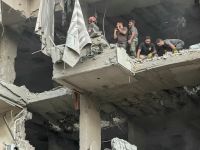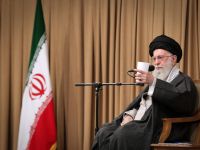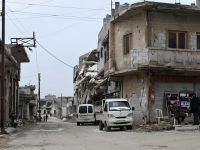Lebanon’s uprising has acted as a cauldron for artistic production, inspiring artists to contribute across a range of media, from murals to photos and, more recently, screen-printing.
On the buoyant, crowded street between Riad al-Solh Square and Martyrs’ Square Saturday night, surprised protesters gathered around a mobile screen-printing machine. Nearby, a truck blasted music as crowds sang, cheered, danced and waved flags.
Farah Fayyad, an independent graphic designer and screen-printer who runs Nice Nice Prints, and several others were hard at work - taking names; printing T-shirts; trying to keep the crowd away from the rotation range of the four-panel screen-printer; hanging newly printed shirts on the grille of the shop behind them that had earlier finished putting up metal barriers to protect its glass front.
The team was screen-printing designs onto whatever people brought them - or for those unprepared, on white T-shirts they’d brought along. It was all for free.
Fayyad said she and graphic designer and illustrator Siwar Kraytem of Studio Safar had come up with the idea.
“Siwar is an old friend who is also very into screen-printing,” Fayyad told The Daily Star by email Sunday after a busy night’s work. “We ran into each other at a road block last week and she spontaneously suggested that we should try to do something related to printmaking and from there it kind of snowballed.”
{"preview_thumbnail":"https://cdn.flowplayer.com/6684a05f-6468-4ecd-87d5-a748773282a3/i/v-i-e…","video_id":"ecdb6e6f-661c-49bc-ade5-c51a5e432b94","player_id":"8ca46225-42a2-4245-9c20-7850ae937431","provider":"flowplayer","video":"Lebanese Protesters Denounce Central Bank Chief's Comment on Anti govt Rallies"}
Fayyad said the initiative was funded by Salim Samara, her partner at Nice Nice Prints who also runs a shop called SS Silkscreen.
“Salim helped us prepare the screens and materials and tools we need,” she said.
“He’s a huge supporter of this project and was more than happy to give us everything we needed.”
They also had a dedicated group of friends who helped with the logistics of what Fayyad called a “very unexpected intervention.”
“I think most of us have been extremely inspired by the revolution, and felt that it would be nice to contribute something more, especially given that we have certain skills and tools,” Fayyad said of those involved.
“We wanted to contribute to the revolution in a way that we are familiar with and we wanted to see people wearing slogans that are relative to what’s happening.”
The designs they were printing were by five different Lebanese artists and type or graphic designers - Kraytem, Joseph Kai, Kristyan Sarkis, Tracy Chahwan and Khajag Apelian. “We felt they were the strongest messages that we’ve been seeing around,” Fayyad said of the designs. “They’re also quite varied both visually and in tone of language. So we felt that they are a good set.”
Chahwan’s features three women and the word “Revolution” in Arabic. Sarkis’ reads “From tyranny blossoms disobedience.”
Kraytem’s features the iconic Beirut landmark the Egg, which has been reclaimed as a public space during the popular uprising and even used as a location for dialogue, hosting teach-ins and discussions drawing large crowds. The design is accompanied by the words “The revolution has hatched.”
Fayyad said the prints had all been popular, but that Saturday night saw a spike in requests for the Egg.
In the roughly 3 1/2 hours they were set up that evening, she said they went through 100 white T-shirts and that around another 150 people had brought their own items.
“Some people were printing on bandanas, papers, random items they were wearing, jackets etc,” she said. “People were taking their clothes off so we could print for them, it was hilarious and fun and just really cool.”
Fayyad said people’s reactions had been very positive.
“Some think we’re a little crazy for dragging this huge screen-printing table out into the streets, but they love it,” she said. “For a lot of them it’s the first time they see this kind of process, so for us that alone is wonderful. They also really appreciate the fact that it’s free.
“We’ve been interacting with all kinds of people that we don’t usually get a chance to be around,” Fayyad added.
“Everyone has been so helpful and collaborative that really this experience was probably the most fulfilling thing we’ve ever done.”
This article has been adapted from its original source.








